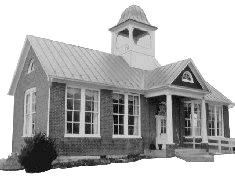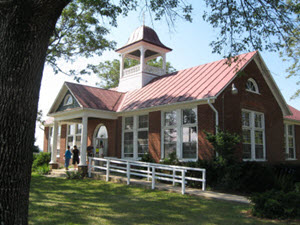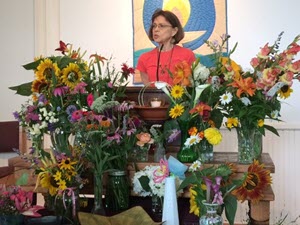
The Dale Enterprise Schoolhouse and HUU
(a history) by Chris Edwards (Updated in July 2009 from article printed in the HUU Review, newsletter ofHarrisonburg Unitarian Universalists, Spring 2000)
Download
Our History
![]()
The History of Harrisonburg Unitarian Universalists (in short):
Harrisonburg had earlier, fledgling UU congregations in the 1960s and 1980s. The present congregation began forming in 1989 and received a charter in 1991, making it part of the national Unitarian Universalist Association. After several years of meeting in homes and rented spaces, the congregation in 1994 purchased our current property (site of the former Dale Enterprise School, built in 1909). Our religious education building was constructed behind the schoolhouse/sanctuary in 1996-97.
We have had alternating periods of lay leadership and ministry. Currently we are a lay led congregation.
The following is a history of our building.
The Dale Enterprise Schoolhouse: A school. A church.
 The spot of land occupied by Harrisonburg Unitarian Universalists became the site
of a systematic quest for enlightenment 132 years ago.
The spot of land occupied by Harrisonburg Unitarian Universalists became the site
of a systematic quest for enlightenment 132 years ago.
In 1877, Peter S. Heatwole and his wife, Nancy, deeded a parcel of their farm consisting of "80 poles" (i.e., rods, or about half an acre) to Rockingham County for $125, to be used as a school. Piney Grove School was built there in 1885.
A photo shows about 30 children in front of that small frame building, surrounded closely by woods. The foundation of that first, one- or two-room school lies beneath the front yard of the present, century-old building. A site map indicates Piney Grove School was set back only a few feet from U.S. 33, a.k.a. the Rawley Pike, then "H&R Springs Turnpike." By 1952, a newspaper article would note "There are few trees left of the pine grove."
Lloyd Heatwole Burkholder recalls those trees were "old native yellow pine." He says that when he helped clear land on the site, their resin was so thick that "you had to carry kerosene to put on the crosscut saw or it would just gum up the works."
The frame building was razed in the summer of 1909 to make way for the brick Dale Enterprise School -- the landmark little red knoll-top schoolhouse that is our congregation's home. Some materials from a log school at Weavers Church had been used to construct Piney Grove School; in turn, some of that school's materials went into the present building, which opened in the fall.
In a 1914 history of Rockingham County schools, Superintendent George Hulvey wrote, "The (school) board has built a beautiful three-room brick house at Dale Enterprise. This supplied a crowded single school on the site of the new house" as well as consolidating several smaller schools. Hulvey's report added, "The house is supplied with water from the Harrisonburg mains, and is modern except its lack of sanitary toilets."
The county built the cupola, but children's families purchased the bell from Sears Roebuck. Lloyd Burkholder -- a great-grandson of Peter Heatwole -- says his father and a friend rode in a spring wagon with the bell after it arrived at the rail depot in Harrisonburg. They rang the bell continuously en route to its destination.
A photo in the 1914 book shows about 50 children in front of the school. Some sit on a fence; one, on a bicycle. Girls hold hands in a circle.
An interior photo shows about 35 young people seated on long benches, their heads bent as if in deep study or prayer. A man stands at a chalkboard to the side. One massive book sits on the teacher's otherwise bare desk.
A panoramic photo from 10 years later remains in our building today. It's perhaps six inches deep and a yard wide. The handwritten caption reads, "Dale Enterprise Literacy Society Reunion – 39th anniversary – Aug. 2, 1924." About 150 men, women and children are pictured in front of the schoolhouse. Many look solemn; some smile. Women's clothing ranges from dark dresses and bonnets to a sprinkling of "Jazz-Age" chemises. Some men wear "plain" coats.
A few buggies, and one automobile, show in the background. The front of the building, and Mole Hill behind it, look much like now. There are shade trees, though none are the same as those standing today.
Local historian John W. Wayland wrote in 1912 of the Dale Enterprise Literary Society's origin: "In 1885, one evening in the dark, eight young men met at a fence corner, near Dale Enterprise, and sat on a log. They were tired but not exhausted; they were in the dark, but were seeking light. They organized a society for mutual improvement; they decided to buy books and read them, and to talk together of what they read...Their motives were misunderstood, their aims questioned, the outcome dreaded."
"It was higher education," Lloyd Burkholder says.
The 1976 book, The Heartland: Rockingham County, says the eight young men were "a different group of Mennonites who dared to seek a higher education." It says the group -- a majority of whom were surnamed Heatwole -- met in the woods behind the schoolhouse and discussed "a new and different way of life."
The Heartland book, compiled by Mr. Burkholder's sister, Nancy Hess, adds that "times changed" and the community accepted the group. Some people have suggested it helped provide the seed for what is now Eastern Mennonite University.
Dale Enterprise School served grades 1-7 in three "combination" classes. Mr. Burkholder attended the school from 1932 to 1940. He lived near Belmont. "First I walked. Later, I got a bicycle," he says.
The school acquired a bus during those years -- probably after the New Erection School burned down and its pupils had to be transported there.
The area that is now our big, front room – the sanctuary – was divided into two rooms, with a hall down the center. Mr. Burkholder recalls that Ada Neff, who came from Timberville, taught grades 1-3 in the east room, while the Rev. Harold Eshleman (who would remain until the school was closed) taught the middle grades in the west room. Ray Emswiler taught the oldest children in a back room where an office, multi-purpose room, kitchen and those originally-lacking "sanitary" facilities are located now.
The curriculum was basic "three R's." Books fit in small satchels. "You got a lot of work on the chalkboards," Mr. Burkholder says. Giant ABC's circled the top of a room.
The bell rang to signal lunch and recess as well as the start of school. The approximately 50 pupils brought bag lunches. Bathrooms were still outdoors. Boys hauled buckets of coal from the dusty basement to big classroom stoves.
Families included Shiffletts, Goods and Shenks. They belonged to several denominations, including "Old Order" and other Mennonite churches. Devotions were part of the school day.
Teachers Eshleman and Emswiler led "shaped-note" singing. The back room was used for crafts, including plywood birds and ducks. Ms. Neff had Mr. Burkholder make her a stepping stool.
To raise money for playground equipment, the children sold ads to be printed on canvas panels used as part of the school's stage. Advertisers included Whitesel Bros., where Mr. Burkholder -- who now lives near Mount Clinton -- would spend his career repairing farm equipment. The portable stage was put up in the back room for pageants, recitations and concerts.
A playground behind the school featured seesaws and a sort of merry-go-round. Girls played softball; boys, baseball, around what is now the parking lot. A baseball team competed with two nearby schools. By necessity, Mr. Burkholder recalls, "There were some sort of heavy wires over the windows on the baseball side."
Double desks were equipped with holes that had held inkwells a generation earlier. Girls and boys were seated separately. Punishments included time on a corner "dunce stool," and a whack on the palm with a ruler.
Mr. Burkholder completed high school at the Mount Clinton School, which later served as an elementary school until 2000 and has been purchased by a local church.
By chance, HUU had a charter member who played a part in Dale Enterprise School. It was where the late Lucy Dambekalns did her student teaching from January through March, 1936, while attending Harrisonburg State Teachers College (now James Madison University).
Lucy remembered coming in the front door, walking toward the back and turning left to reach the fifth- and sixth-grade classroom where she taught from 9:30 to 11 a.m. Lucy, a math and science major, taught mainly science. Her class had between 30 and 35 pupils.
"In 1936, it was a fairly old looking building," Lucy recalled. She said the children's behavior and attendance were exemplary. "There was a great community feeling," said Lucy. When her brother was killed in an accident, Lucy recalled, "Those kids were so concerned and sympathetic. I felt the warmth of the community." Lucy, who had grown up in Culpeper, went on to become a Library of Congress librarian, later retiring to her farm near Timberville. She passed away in the spring of 2009, at 93.
In July 1952, several hundred people gathered on the Dale Enterprise School grounds to sing "When The Roll Is Called Up Yonder" and "The School House On the Hill." The occasion was the 100th anniversary of schools in the Dale Enterprise area. They had begun with a log Walnut Grove School, circa 1852.
(The intervening years make up a tiny fraction of the eons that have elapsed since our landmark -- the low, softly rounded Mole Hill -- was a volcano. Time, one wag at HUU has said, made a Mole Hill from a mountain...)
Dale Enterprise School, built and opened in 1909, closed when Pleasant Valley Elementary School opened in 1963.
Getting rid of the property was a complicated process for the county. Peter Heatwole had stipulated in 1877 that his piece of land would revert to the family if it ceased being used for a public school. The schoolyard's approximate 2.1 acres were found to consist of three parcels: that piece; an adjoining half-acre strip acquired from Peter Heatwole without a deed transfer; and an acre behind those tracts that neighbors Warren P. and Mary R. Heatwole conveyed to the county for $140 in 1939.
A 1974 agreement in Rockingham County Circuit Court said that "uncertainty has arisen among the heirs of Peter S. Heatwole and the Rockingham County School Board as to which of the parties would have better claim" to the combined tracts. The parties agreed to sell the property at auction "to avoid expensive and protracted litigation."
C. Sheldon Layman and Chester L. Bradfield, as the partnership C&S Developers, bought the property for $20,500 at an auction on Court Square that year. The school board received 60% of proceeds. The remaining 40% was split among 67 descendants of Peter and Nancy Heatwole, who Mr. Burkholder says were located chiefly by family member Samuel Early.
The building stood empty and fell into disrepair for more than a decade. In 1975, it was leased by the Rockingham Christian School. Under headmaster Mr. Shenk (a Baptist), the nondenominational school emphasized phonics and "the individual priesthood of the believer." There were 22 students in grades K-7.
The county had given Rev. Eshleman the bell when the building was auctioned, but Mr. Burkholder says it returned at neighbors' urging. That occurred during the Christian school's somewhat brief operation.
The building returned to public use in 1979 when it became the first local alternative school. Once again, someone destined to become a charter HUU member played a role. Cathy Strickler was a guidance counselor in the alternative school during its first year of operation. It was one of two schools serving at-risk Rockingham County and Harrisonburg high school students under a federal CETA grant. Cathy says about 15 students, aged 16 to 18, attended (while the city's Lucy Simms School accommodated the younger group). Dale Dodrill was principal. Cathy recalls that daily routines were "informal."
The school closed a few years later when funding ran out. But alternative schools have shown dramatic growth lately. Cathy notes that an alternative school serves those who, for whatever reason, "don't thrive" under the standard school program. (A thought: If we take that sentence and substitute "church" for "school," what do we get? Or – for those who don't like calling HUU a "church" – substitute an alternative.)
The building was standing vacant again in 1983 when the American Lutheran Church purchased it from C&S for the then-new Shepherd of the Valley Lutheran Church.
The church took out the center walls to make the sanctuary. "We were quite happy there," says charter member Mary Waggy. The Lutherans used a school drinking fountain for the baptismal font, and a teacher's lectern as the pulpit. Mrs. Waggy says the congregation found the building's scholarly past meaningful, and took the above items when the church moved to its present quarters in Bridgewater. But the bell remains.
In 1984, members of the Harrisonburg Friends Meeting asked Shepherd's then-pastor, Ray Ideus, about renting space. The local Quaker group, founded in the late 1970s, had met in members' homes. "He offered to let us meet there in the afternoon until we could find another church," says Friends group member Doris Baker. What began as a temporary arrangement lasted 16 years, she noted, under both Lutheran and HUU ownership.
"The place has good vibes. You know that good things have gone on in there," she said. The Friends moved out in 2000 to buy a church in Dayton.
Harrisonburg Unitarian Universalists purchased the Dale Enterprise building on Aug. 16, 1994.
HUU, chartered in 1989, had previously met in the Beth El Congregation temple and the "Meeting Place" on Va. 42 (affectionately dubbed "the OK Corral" because of its Western-themed murals, the latter building has since housed several businesses). Our religious education building was constructed in 1996-97 behind the old schoolhouse.
Spirits continue to watch over our quest for enlightenment.
The centennial:
Our schoolhouse’s hundredth anniversary was marked by a gathering of more than 100 alumni and faculty (including a 106-year-old teacher) on July 18, and by our Sunday service on July 19, 2009. That Sunday, in front of a Channel 3 News camera, two alumni/guests, brothers Dan and Eldon Bowman, shared memories of their school days from the late 1940s and early ‘50s. These included walks to the store across the street to buy candy bars; a teacher/pastor’s controversial “hellfire” preaching; and “cabins” – small lean-to’s behind the playground which served as the domains of cliques. We heard the harrowing tale of the time Dan Bowman’s feet crashed through the ceiling directly over what is now our pulpit! (Dan became a piano-tuner, and has worked with our piano.) Another guest at the service, Rockingham County school historian Dale McAllister, shared the broader historical picture. (Q: What does Dale Enterprise have in common with Pompeii? A: Each once sat beneath a volcano. Those were Vesuvius . . .and Mole Hill.) Read Dale McAllister talk on the History of Dale Enterprise Schoolhouse.
--by Chris Edwards
(updated July 2009)
References:
- Rockingham County Circuit Court: Deed book 1302, page 327; book 694, p. 126; book 654, p. 480; book 436, pp. 495 and 519; book 177, p. 29; and book 23, p. 201.
- John Wayland, A History of Rockingham County (1912), p. 436.
- Rockingham County Schools (1914).
- The Heartland: Rockingham County (1976).
- The Daily News-Record, 7/16/1952 and 12/4/1975.
- Shenandoah Valley Heritage Museum library, Dayton.
Edith Layman Rhodes book, Dale Enterprise School - It's about the history of a small public school that was open from 1909 to 1963. The book contains historical facts, lists of students, very short biographical information on the teachers, memories from some students, and lots of photographs. It also contains historical information about the local community. (352 pages, 149 photographs, 38 teachers, over 1,000 students)
For the latest sermons and events at HUU, visit our Community Cafe.
Inclement
Weather Policy
Worship
Service Materials


UUs on YouTube
Our denomination has an official presence on YouTube! The Unitarian Universalist Association's YouTube site includes several videos and lots of interesting commentary.
Harrisonburg Unitarian Universalists 4101 Rawley Pike | Harrisonburg,
VA 22801
Mailing Address: | PO Box 96 | Harrisonburg, VA 22803
| (540) 867-0073 | Webmaster
HUU is a member of the Southern
Region of the Unitarian Universalist
Association
Privacy Policy &
Disclaimer
Site Design & Maintainence : Expression
Web Tutorials & Templates


